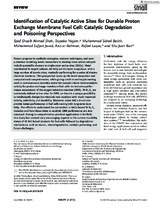Identification of Catalytic Active Sites for Durable Proton Exchange Membrane Fuel Cell: Catalytic Degradation and Poisoning Perspectives
Autor
Shah, Syed Shoaib Ahmad
Najam, Tayyaba
Bashir, Muhammad Sohail
Javed, Muhammad Sufyan
Rahman, Aziz-ur
Luque, Rafael
Bao, Shu-Juan
Editor
WileyFecha
2022Materia
Catalytic poisoningDurability
Electrocatalysts
Fuel cells
Metal organic frameworks (MOFs)
Oxygen reduction reaction (ORR)
Single-atom active sites (SACs)
METS:
Mostrar el registro METSPREMIS:
Mostrar el registro PREMISMetadatos
Mostrar el registro completo del ítemResumen
Recent progress in synthetic strategies, analysis techniques, and computational modeling assist researchers to develop more active catalysts including metallic clusters to single-atom active sites (SACs). Metal coordinated N-doped carbons (M-N-C) are the most auspicious, with a large number of atomic sites, markedly performing for a series of electrochemical reactions. This perspective sums up the latest innovative and computational comprehension, while giving credit to earlier/pioneering work in carbonaceous assembly materials towards robust electrocatalytic activity for proton exchange membrane fuel cells via inclusive performance assessment of the oxygen reduction reaction (ORR). M-Nx-Cy are exclusively defined active sites for ORR, so there is a unique possibility to intellectually design the relatively new catalysts with much improved activity, selectivity, and durability. Moreover, some SACs structures provide better performance in fuel cells testing with long-term durability. The efforts to understand the connection in SACs based M-Nx-Cy moieties and how these relate to catalytic ORR performance are also conveyed. Owing to comprehensive practical application in the field, this study has covered very encouraging aspects to the current durability status of M-N-C based catalysts for fuel cells followed by degradation mechanisms such as macro-, microdegradation, catalytic poisoning, and future challenges.

